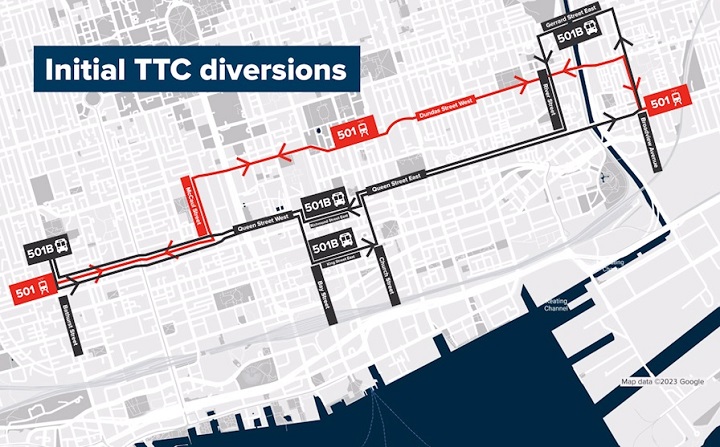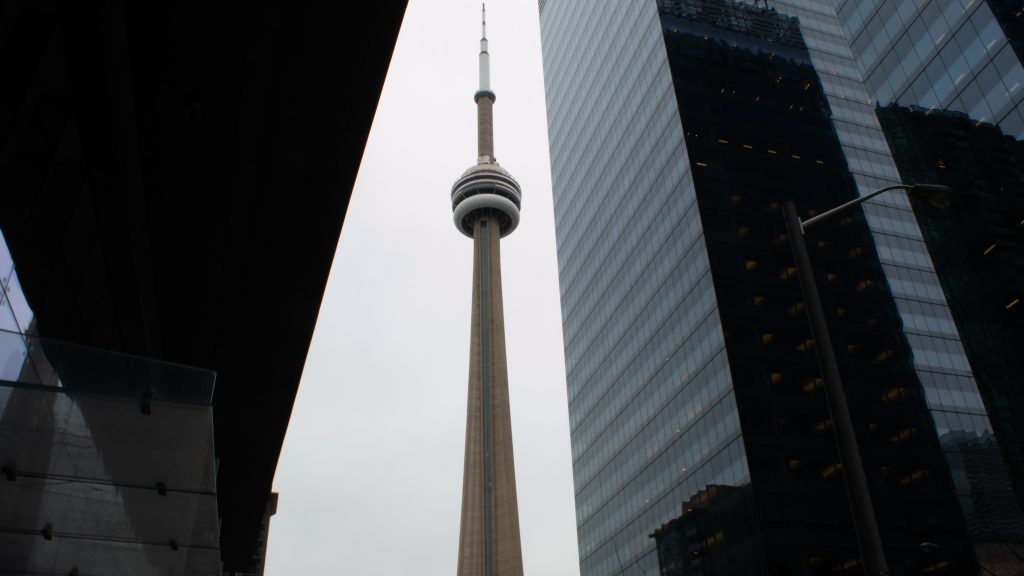Ontario Line forces 4.5-year partial closure of Queen Street, TTC launching 2-phase diversion
Posted April 30, 2023 7:30 pm.
Last Updated April 30, 2023 8:48 pm.
As construction of the Ontario Line ramps up in downtown Toronto, part of Queen Street is set to be closed for at least four-and-a-half years in order to build a major interchange station.
Queen Street will be closed to vehicles between Bay and Yonge streets as well as Yonge and Victoria streets as of May 1. However, Metrolinx officials said pedestrian access along the affected parts of Queen Street will be maintained as will vehicular traffic on Yonge Street.
“We understand that that’s a long stretch of time. But by doing it this way with a full closure, we’re actually going to speed up construction of the Ontario Line Queen station by about a year,” James Wattie, a spokesperson with Metrolinx, told CityNews when asked about the lengthy closure.
“Instead of going and doing partial closures, like you might see with other construction projects where it’s closed one weekend or closed for a few days here and there, this gives our construction teams time and the space to do what they need to do as fast as they can and as safely as they can.”
The station will need to be built under the existing TTC Line 1 Queen subway station, which will keep operating throughout the closure. According to staff with Metrolinx, the provincial transportation agency overseeing the consortia of companies building the 15-stop, 16-kilometre subway line, it will be the busiest connection point on the Ontario Line with other transit lines.
“We’re estimating more than 16,000 customers will use the station during the busiest travel hour,” he said while describing the complex nature of the build.
RELATED: City of Toronto announces priority travel routes to alleviate Ontario Line traffic woes
The closure of parts of Queen Street by the provincial government has forced the Toronto Transit Commission (TTC) to put in place a two-phase diversion plan.
“We ask our customers to bear with us,” TTC spokesperson Stuart Green told CityNews ahead of the closure.
“We don’t know what the real-world impacts of this [are] going to be because you know the streetcars are moving and our buses are moving in mixed traffic.”
The first phase, beginning on May 1 and estimated to last 10 to 12 months, will see a continuation of streetcars and buses.
Westbound shuttle buses from River Street will go along Queen Street East, down Church Street, across Richmond Street, up Bay Street and west on Queen Street to Bathurst Street.
If you’re heading east, it’s the same route except buses will go eastbound along King Street before going north on Church Street. Eastbound buses will go to Broadview Avenue, north to, and west on, Gerrard Street East and then south on River Street before heading westbound on Queen Street East.
501 Queen streetcars will still be operating, but diverting on McCaul Street, Dundas Street and Broadview Avenue.

A map shows how TTC streetcars will be diverted and how shuttle buses will operate. This first phase of diversions will be in place until new streetcar tracks open on Richmond and Adelaide streets. CITYNEWS
Green encouraged people to switch to the 504 King and 505 Dundas streetcar lines, if possible.
Meanwhile, TTC crews are building new tracks on Richmond and Adelaide streets to provide westbound and eastbound connections, respectively, between York and Church streets. The work is set to be done in 2024. Once it’s finished, the shuttle buses will stop and streetcars will be using these new tracks for the rest of the Queen Street closure.
“This is really one of those classic cases of short-term pain for long-term gain. I know four or five years doesn’t sound like short-term, but ultimately it is in the grand scheme of things,” Green said, noting the new streetcar tracks will give the TTC streetcar network extra flexibility.
“This is transit infrastructure that will be around for decades and generations to come. It’s needed in the city of Toronto.”
The Queen Street closure runs right through the western end of Coun. Chris Moise’s Toronto Centre ward and he told CityNews he has been hearing from residents.
“It’s caused a lot of anxiety not only for me but people who live in my ward, but I have had conversations with Metrolinx just to make sure that we’re all on the same page,” he said.
RELATED: Little Jamaica business owners hope for stronger year amid Eglinton Crosstown delay, COVID
“Toronto Centre, more specifically Yonge and Queen, is a hub. The Eaton Centre is there, The Bay is there, we have theatres in the area and it’s also adjacent to the Financial District. So we all know the importance of the downtown core and its importance to be a vibrant place.”
Moise said he’s heard particular concerns about how business operators will be impacted.
“We’ve seen what happened on Eglinton. You know, a lot of businesses went under. We’re trying to support businesses the best that we can … by providing some funding through the City.”
CityNews asked Wattie about what’s being done to ensure the concerns of business operators are being addressed.
“Access to businesses will be maintained throughout the entire closure and that also includes two loading docks, but we keep an open line of communications with business throughout all of our projects.”










